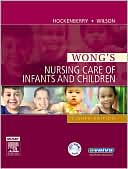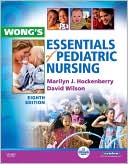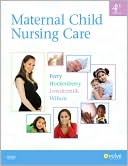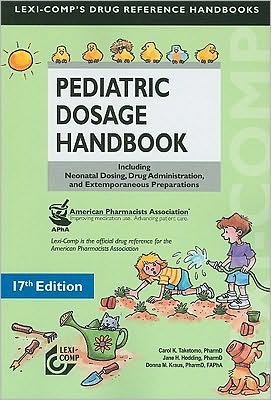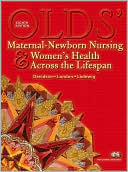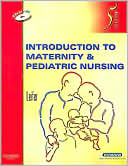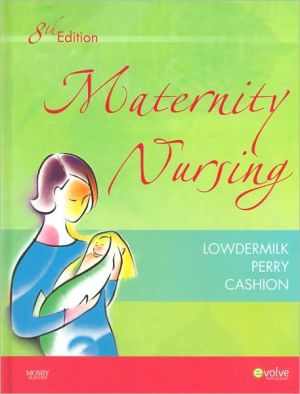Wong's Nursing Care of Infants and Children
Search in google:
The most trusted authority in pediatric nursing, Wong's Nursing Care of Infants and Children provides unmatched, comprehensive coverage of pediatric growth, development, and conditions. Its unique 'age and stage' approach covers child development and health promotion as well as specific health problems organized by age groups and body systems. Leading pediatric experts Dr. Marilyn Hockenberry and David Wilson provide an evidence-based, clinical perspective based on nearly 30 years of hands-on experience. Easy to read and extensively illustrated, this edition focuses on patient-centered outcomes and includes updates on topics such as the late preterm infant, immunizations, the H1N1 virus, and childhood obesity.• A clear, straightforward writing style makes content easy to understand. • Unique Evidence-Based Practice boxes help you apply both research and critical thought processes to support and guide the outcomes of nursing care. • Unique Atraumatic Care boxes contain techniques for care that minimize pain, discomfort, or stress. • Unique Critical Thinking exercises help you test and develop your own analytical skills. • A unique focus on family content emphasizes the role and influence of the family in health and illness with a separate chapter, discussions throughout the text, and family-centered care boxes. • Nursing Care Guidelines provide clear, step-by-step, detailed instructions on performing specific skills or procedures. • Unique Emergency Treatment boxes serve as a quick reference for critical situations. • Unique Cultural Awareness boxes highlight ways in which variations in beliefs and practices affect nursing care for children. • A developmental approach identifies each stage of a child's growth. • Health promotion chapters emphasize principles of wellness and injury prevention for each age group. • Student-friendly features include chapter outlines, learning objectives, key points, references, and related topics and electronic resources to help you study and review important content. • A community focus helps you care for children outside the clinical setting. • Nursing Care Plans include models for planning patient care, with nursing diagnoses, patient/family goals, nursing interventions/rationales, expected outcomes, and NIC and NOC guidelines. • Nursing Tips include helpful hints and practical, clinical information, and Nursing Alerts provide critical information that must be considered in providing care.• Unique! Quality patient outcomes are highlighted for major diseases and disorders, reflecting the QSEN focus on patient-centered outcomes. • Pathophysiology reviews include special illustrations to explain complicated disease processes. • Complementary & Alternative Therapy boxes include timely information on alternative medicine as a part of complete, comprehensive care. • Research Focus boxes include the latest research impacting pediatric nursing today. • Drug Alerts highlight important drug-related information for safe, appropriate care. • Updates include coverage of hot topics such as the late preterm infant, immunizations, the H1N1 virus, and childhood obesity. • Unique! Family-Centered Care boxes include features on family-related topics. Doody Review Services Reviewer:C. Angela Masters, BSN(University of New Mexico Children's Hospital)Description:This comprehensive book identifies all major concepts involved in the care of children and their families. Purpose:This book differs from previous editions in that the family centered care philosophy is the center concept. In addition, traumatic care and continuity of care is addressed based on the development of a therapeutic relationship between nurse, child, and family.Audience:Practicing nurses are the intended audience, although nursing students will also use this book.Features:This is a comprehensive overview of care for children and their families. It includes health promotion strategies for every age level, which is important because many children are not hospitalized and receive care in the community.Assessment:Due to changing technology in healthcare, new editions of textbooks are necessary to reflect up-to-date practice and concerns. This is a well written book, although rather large (almost 2,000 pages), which gives me some concerns about repetition. The book is appropriate for nursing students through practicing nurses.
Unit IChildren, Their Families, and the NurseCh. 1Perspectives of Pediatric Nursing1Ch. 2Social, Cultural, and Religious Influences on Child Health Promotion30Ch. 3Family Influences on Child Health Promotion64Ch. 4Community-Based Nursing Care of the Child and Family103Ch. 5Hereditary Influences on Health Promotion of the Child and Family110Unit IIAssessment of the Child and FamilyCh. 6Communication and Health Assessment of the Child and Family139Ch. 7Physical and Developmental Assessment of the Child170Unit IIIFamily-Centered Care of the NewbornCh. 8Health Promotion of the Newborn and Family240Ch. 9Health Problems of the Newborn295Ch. 10The High-Risk Newborn and Family333Ch. 11Conditions Caused by Defects in Physical Development415Unit IVFamily-Centered Care of the InfantCh. 12Health Promotion of the Infant and Family493Ch. 13Health Problems During Infancy554Unit VFamily-Centered Care of the Young ChildCh. 14Health Promotion of the Toddler and Family591Ch. 15Health Promotion of the Preschooler and Family628Ch. 16Health Problems of Early Childhood649Unit VIFamily-Centered Care of the School-Age ChildCh. 17Health Promotion of the School-Age Child and Family698Ch. 18Health Problems of Middle Childhood739Unit VIIFamily-Centered Care of the AdolescentCh. 19Health Promotion of the Adolescent and Family802Ch. 20Physical Health Problems of Adolescence839Ch. 21Behavioral Health Problems of Adolescence869Unit VIIIFamily-Centered Care of the Child with Special NeedsCh. 22Family-Centered Care of the Child with Chronic Illness or Disability905Ch. 23Family-Centered End-of-Life Care947Ch. 24The Child with Cognitive, Sensory, or Communication Impairment977Ch. 25Family-Centered Home Care1016Unit IXThe Child Who Is HospitalizedCh. 26Family-Centered Care of the Child During Illness and Hospitalization1031Ch. 27Pediatric Variations of Nursing Interventions1101Unit XThe Child with Disturbance of Fluid and ElectrolytesCh. 28Balance and Imbalance of Body Fluids1171Ch. 29Conditions That Produce Fluid and Electrolyte Imbalance1207Ch. 30The Child with Renal Dysfunction1255Unit XIThe Child with Problems Related to Transfer of Oxygen and NutrientsCh. 31The Child with Disturbance of Oxygen and Carbon Dioxide Exchange1303Ch. 32The Child with Respiratory Dysfunction1343Ch. 33The Child with Gastrointestinal Dysfunction1416Unit XIIThe Child with Problems Related to Production and Circulation of BloodCh. 34The Child with Cardiovascular Dysfunction1464Ch. 35The Child with Hematologic or Immunologic Dysfunction1530Unit XIIIThe Child with Disturbance of Regulatory MechanismsCh. 36The Child with Cancer1584Ch. 37The Child with Cerebral Dysfunction1641Ch. 38The Child with Endocrine Dysfunction1703Unit XIVThe Child with a Problem that Interferes with Physical MobilityCh. 39The Child with Musculoskeletal or Articular Dysfunction1757Ch. 40The Child with Neuromuscular or Muscular Dysfunction1832App. AFamily Assessment1870App. BDevelopmental/Sensory Assessment1874App. CGrowth Measurements1881App. DCommon Laboratory Tests1895App. ENANDA-Approved Nursing Diagnoses 2001-20021904App. FTranslations of Wong-Baker FACES Pain Rating Scale1905
